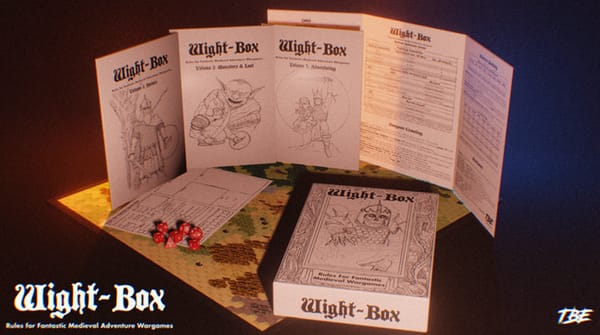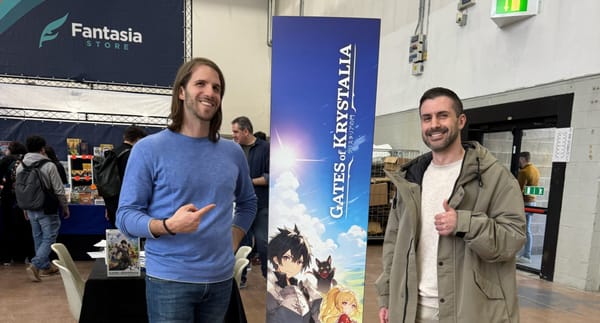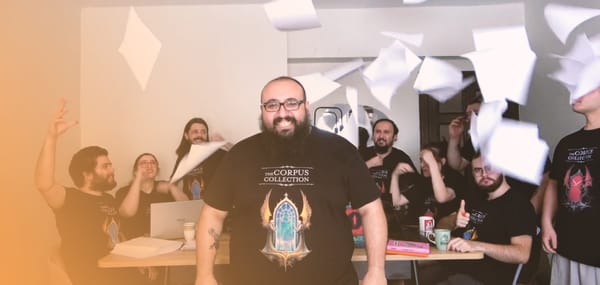The Art of the One-Shot - A Conversation with J.C. Connors

In a tabletop RPG landscape filled with sprawling campaigns and complex systems, 1ShotAdventures and 1 Shot Adventure YT offers something refreshingly bold and approachable: tightly crafted, genre-spanning adventures designed to be played in a single session.
Behind this growing library of free content stands J.C. Connors—a game designer with decades of experience in both the video game and tabletop industries, and a passion for storytelling that began in the red box era of Dungeons & Dragons.
What started as a personal reaction to a disappointing con game quickly evolved into a mission: empower Game Masters to try something new, and make it as easy and fun as possible.
With over 35 downloadable one-shots, ranging from Lovecraftian Ice Age horror to 1960s spy thrillers, Connors has built a rare resource—adventures that are system-agnostic, print-and-play ready, and full of evocative, memorable hooks.
In this interview, Connors shares the creative philosophy behind 1ShotAdventures (check also YT), his iterative design workflow, his views on the evolving TTRPG ecosystem, and his surprisingly nuanced take on AI tools in the creative process.
Whether you’re a seasoned GM looking to expand your table’s repertoire or a designer seeking insight into sustainable indie publishing, this is a must-read conversation with a creator who truly understands both the art and accessibility of one-shot storytelling.
Onwards!
What inspired you to start 1ShotAdventures, and how has the project evolved over the years?
J.C. Connors - I was inspired to start the site after a visit to the Origins game convention a few years ago. I was very excited to play in an old west Call of Cthulhu adventure. I love old west and horror and couldn’t wait! Sadly, the session underwhelmed in every way – the GM wasn’t prepared, the adventure wasn’t well-structured, it definitely wasn’t scary, and the table got bored fast.
I left disappointed, vowing that I would write a better old west horror adventure for a convention! I wrote my own old west horror adventure, The Black Mine of Teihiihan, a week or two later, ran it at a local convention, and decided to post it online as an example for other GMs looking to run something similar.
I got such great reception on that one, I kept going with new ones. I guess you could say it if it wasn’t for that terrible convention game, I would never have created 1ShotAdventures!
As the site evolved, I was surprised to hear from many gamers who were afraid to pitch new games or RPG genres to their friends. “My friends will only play D&D.” I heard that all the time. But folks taught me that well-prepared one-shots are very effective at convincing your group to try something new.
If you ask your friends to start a new campaign, especially in a new system, you’ll get resistance. That’s a big ask with a lot of risks! But if you ask your friends to play a single adventure, where they have to do very little upfront work like creating characters, and then tell them why you want to try it out, almost everyone says yes.
And so I double-downed on making my adventures easy for GMs to prep and run. I always hope that GMs can grab one of my adventures, print out the handouts and characters, and be ready to go.
How do you choose the genres and settings for your one-shot adventures?
I think my inspiration comes from similar places as other GMs. Sometimes, it’s a TV show or movie or book that inspires my next one. Other times, a friend challenges me. I had one friend who had been begging for an ice age adventure for over twenty years, and so I finally gave in and wrote one.
And other times, my community is very influential. They’ve been asking for cyberpunk for years, so I finally bowed to their amazing relentlessness and did one last year.
What’s your creative workflow like – from idea to finished PDF?
It’s free-form and very iterative. My professional background is building videogames, where I always found that the simultaneous convergence of design, engineering, and art leads to something special. Videogames aren’t typically built in a linear fashion. So I approach my adventures in the same way.
I’ll start with a core concept, make a list of things I want to include, and come up with an opening that I think will catch the players’ attention. For example, in my 1960s spy adventure, Never Forget to Die, I knew I wanted to start the adventure with one of the PCs about to be tortured, while others were parachuting in to rescue them.
And I knew that being a spy adventure, I needed exotic locations, so I picked a few sites that I thought would make great scenes. I wrote the first 20% without having a strict plot.
And then I usually bounce around. I come up with some pregenerated character concepts. I come up with a title and work on a few treatments until it has the feel I want. I design the layout of the adventure, maybe a map or two, and then I go back to the plot. It all intertwines and mixes together until completion, with a lot of edits and rewrites along the way.
But sometimes it all backfires, and I get 30% through an adventure but the puzzle-pieces don’t work. I have a few in that state. I think that’s okay, I may go back to them some day.
How do you balance narrative freedom with mechanical structure in your adventures?
It depends a lot on the adventure and the genre. While “railroading” is a dirty term in the TTRPG community, I find it’s more nuanced than that. Linear adventures are easier for GMs to prepare and run, more likely to fit into a specific amount of time, and easier for new players to understand.
Some genres work better more linearly. Horror needs tight pacing, clear clues, and big scares, so horror adventures have more linear aspects.
But open-ended sandboxes are great too. I still remember landing on the Isle of Dread – one of the earliest of TSR’s original D&D adventures – and loving that I could go anywhere. I felt like an explorer. So some of my adventures lean into that.
One of my latest ones, the noir Gotham ’39, is almost entirely a sandbox filled with dozens of NPCs with their own agendas, locations, and secrets, and it’s up to players how to navigate through the city. It wouldn’t work linearly.
Lately, my favorite types of adventures feature both linear and free-form segments. They begin with a clear objective, open up to allow for player agency, but also have some defined set-pieces along the way that so players feel like they are advancing the plot.
Are there any themes or story types you find yourself returning to again and again?
I think I published 20 adventures before it occurred to me that they all feature a cave somewhere in them! If I’m philosophical, it’s probably tied into the Hero’s Journey, where it just feels great when the heroes descend into the underworld for their final challenge.
Or, it’s just a callback to my early days in the hobby where I loved the early TSR dungeon adventures like Keep on the Borderland and White Plume Mountain.
Many of your one-shots are system-agnostic or easily adaptable. Why is that important to you?
First, I want to reach as many players as possible! That’s why most of my adventures support at least two game systems. Second, I find it makes me a better game designer when I “port” an adventure from one system to another. Thinking about different systems makes me look at an adventure differently.
How does the adventure change when the system doesn’t have skill rolls? How does it change when a system is more cinematic, and another is gritty? What rules do I have to add to retain the feel of the adventure? Call of Cthulhu has detailed sanity rules, most other systems don’t. Do I have to replicate this, or does it work fine without it?
These are all fun design challenges that give me new perspective on adventure writing. I really encourage up-and-coming game designers to give this a shot – take a Call of Cthulhu adventure and port it to Shadowdark, and watch what works and what doesn’t.
How do you approach designing for both new players and veteran GMs?
It’s very hard. I’ve gotten feedback all over the spectrum. Even veteran GMs can give you different feedback. One person told me an adventure was the easiest thing he ever ran, another told me the same adventure was overwritten and it should have just been a single page with bullet points! I’m still evolving to find the balance.
But lately I’ve been doing YouTube overviews of my adventures, which help new GMs tremendously, and also help veteran GMs decide whether the adventure is one they want to run.
What’s your take on including VTT assets and handouts – are these essential in today’s game design?
VTT assets are very important. Early on, I had so many people reach out to me and say, “JC, I love this adventure, but I can’t run it because there aren’t VTT maps.”
And I personally find this true – if I find an adventure I like, it can take me a few hours to set it up in a VTT. I have to find maps, clip out token art, input NPC stats, etc. I enjoy doing this as a sort of hobby, but it’s hugely time consuming for GMs. So I started including as many assets as I can in my adventures.
How much playtesting goes into each adventure before it's released?
I typically play with my own group first, then make some tweaks and changes before publishing.
How do you see the tabletop RPG landscape changing over the next few years?
The cost to making great content is constantly going down. It’s going to go down more. Open gaming licenses are commonplace, digital publishing is getting easier and easier, and commissioning great art is easy and inexpensive compared to years ago. And none of that counts AI, which is going to lower costs even more.
Even if AI isn’t writing game supplements, it’s going to make it easy for creators to localize their games into different languages, proofread and edit, and summarize feedback from fans. This is positive in that it will allow more and more creators to bring their ideas to the world.
We’ll see more indie games, more fan-created material that rivals the best Wizards of the Coast can publish, and a glut of amazing material for GMs to pick from. But it also means that finding truly amazing material, amid a sea of good material, is going to be harder than ever.
Do you think there's still room for smaller, non-commercial creators to break through in the current market?
Absolutely, but I think creators need to understand that the TTRPG market is as cruel as the videogame market, where tens of thousands of high-quality products are released every year, and most of them go undiscovered.
The number one problem for creators is getting eyeballs on their work. I don’t think anyone knew about my site until The Arkham Files podcast did a wonderful episode on my 1950s horror adventure, Those the Comet Brings.
I wish I could say that was my plan, but it was luck that they found it and decided to run it. Since then, I’ve learned to spend time on “marketing” my stuff, even though it’s free, including YouTube overviews on my channel, engaging with fans on Reddit and Discord, and working with other creators.
No matter how skilled you are, you can’t just create something expect it to get attention anymore.
What recent trends in TTRPGs excite you – and which ones concern you?
The emergence of VTTs makes it so much easier to connect friends together. And VTTs are getting better, and more automated, so it’s easier than ever to to try out a new system. It’s a great trend in the industry.
What concerns me is that as VTTs get more powerful, they start to skirt the line into videogames. I think the now-defunct, Unreal-powered Sigil ran into this problem headlong.
You put 3D monsters and visual effects in your VTT, now suddenly you need animations, pathfinding, physics, etc. Then suddenly everything is very expensive to make, and you’re ultimately on a path that will end in Diablo or Baldur’s Gate, not a tabletop RPG where custom content and imagination fuels player fun.
If VTTs head in this direction, you’re going to see it more difficult for GMs to customize their material, and more expensive for indie RPGs to build good VTT support for their games. And a single VTT might emerge as a winner, which could further stymie new games.
How has the rise of virtual tabletop platforms influenced your approach to adventure design?
It really hasn’t, because I never know if I’m going to play my game in-person or over VTT! But what I would tell GMs running their game over VTT, pick an adventure that works well for that format.
I love that VTTs make some genres easier-than-ever to play, especially big dungeon crawls, or scenarios with lots of combatants. But on the flipside, I find other genres harder over VTT. For example, I rarely run horror over VTT. I think horror is more effective in-person, in a distraction-free dim room with tactile handouts.
You've chosen to release 1ShotAdventures content for free – why take that path?
The main reason is that I am the most passionate about helping the hobby grow. I want to help people try new games and genres, and take the load off of very-busy GMs. I’m not as interested in selling material to a very niche group of already-experienced players.
But since I started the site, I’ve used its success to branch off into YouTube and sponsorships, so I guess you could say that I give away my content for free so I can monetize (a very small amount) in other ways!
Have you ever considered turning your work into a commercial product or running a crowdfunding campaign?
I have considered it, and I may do that in the future. I just want to find the right idea that would warrant the additional work and complexity.
What role does community support (e.g. Buy Me a Coffee, YouTube, social media) play in helping you sustain your work?
My community is fantastic. I often get edits, suggestions, and commentary 24 hours after I publish a new work now, which I almost always incorporate into adventure updates. I’ve had folks create VTT assets that I didn’t have time to include, for example, sending me maps or music or more.
And I get many, many session reports that always delight me and give me new ideas. Recently, someone reached out to me because she had been converting my adventures to her Star Wars Sith apprentices campaign, and reading about how she transformed an old west or 1930’s noir game into her Star Wars setting blew me away.
Do you think there's a viable middle ground between full-time professional publishing and hobbyist contribution?
The advent of open licenses for popular RPGs has really allowed hobbyist creators to become paid professionals. It’s created a sort of middle ground for hobbyists to make money off their creations.
Now, I don’t think it’s MUCH of a middle ground, since there’s not a huge amount of money to be made, but I think more importantly those licenses lend credibility and legitimacy to creators’ works. One of my favorite third-party adventures is Viral for Call of Cthulhu. It’s brilliant, entirely created by a fan, and it wouldn’t have existed without Chaosium’s program allowing creators to do that.
It was a success for both the creator and the company.
Which one-shot are you most proud of and why?
I’m really fond of my Lovecraftian ice age horror adventure, Canyon of the Snow Cairns. I think it has a great blend of cool set pieces and player agency, and players always have amazing stories about how the finale plays out.
Veteran Call of Cthulhu players have had a lot of fun with this one thanks to the originality of the setting. And like I mentioned above, it was a friend’s idea I resisted for decades, so it really speaks to me on how good GMs should always listen to their players, no matter how wingnut their ideas seem.
Would have thought HP Lovecraft and cave men would go together so well?
What do you wish more adventure writers understood about short-form TTRPG storytelling?
Don’t hold back, put all your best stuff into your adventure. I talk to many adventure writers who have strong ideas, but want to save them for the next adventure, or a moment later in their campaign.
This might be why so few official D&D adventures actually have dragons in them – the writers are saving them for later! But I tell writers not to do that – load your adventure up with all your best ideas, your adventure will be more memorable, your players will have more fun, and they’ll ask for more.
If you could collaborate with any other creator or publisher in the TTRPG space, who would it be – and what would you want to build together?
I’m a big fan of Professor Dungeon Master’s adaptations of classic literature. His MacDeath and Frankenstein are breezy and fun for people both familiar and unfamiliar with the original. I’d love to work on a literary adaptation with him. Phantom of the Opera, perhaps, professor?
Have you experimented with using AI tools in your creative process—writing, art generation, layout, or anything else? What’s your take on the role of AI in the future of TTRPG content creation?
AI is a divisive topic, and I think every creator has to figure out for themselves where AI sits in their creative process. There’s not one right answer. I use AI quite a bit, but never to write the adventures themselves. I started years ago with thispersondoesnotexist to generate NPC portraits for my games. Obviously, that’s dark ages technology now.
For my last few adventures, I’ve used NotebookLM to look for plot holes or dead ends, or create a diagram of how my characters are linked to each other. This was really helpful when I was writing a complex noir adventure like Gotham ’39.
For example, it told me I had a character in the adventure that, if killed, could dead end players. It also told me that one character had contradictory motivations! That was very insightful; I would have overlooked that sort of thing myself!
I also used the same tool to create a podcast for my work-in-progress adventure, and I found listening to AI hosts talk about my adventure inspired me to take it in a different direction. That surprised me.
Other times I’ll use AI as a research tool, especially for my historical adventures, where I strive to make them feel authentic. And when I’m playing games with my friends, I sometimes use AI to surprise them. Last year, I tricked my players into playing a one-shot set in the Terminator universe.
They thought they were in a regular modern horror game until they discovered security camera footage with an authentic-looking T-800 staring in the camera. That was an easy video to create with AI, and a delightful moment at our table we’ll remember for years.
But AI is evolving so quickly, I always revisit what I feel good about using, and what doesn’t feel right. At the end of the day, I always want my adventures to feel like they came from my brain and soul.
---
Bio: J.C. Connors is the author of 1ShotAdventures.com, a site for RPG fans that offers over 35 free adventures across different genres and game systems, all designed to make it easy for GMs to bring new games to their tables. His game industry career stretches back over 25 years, and he’s designed and produced dozens of videogames and tabletop games. His first RPG character died from the bite of a carrion crawler while searching for the evil wizard Bargle, in the red box D&D set.





